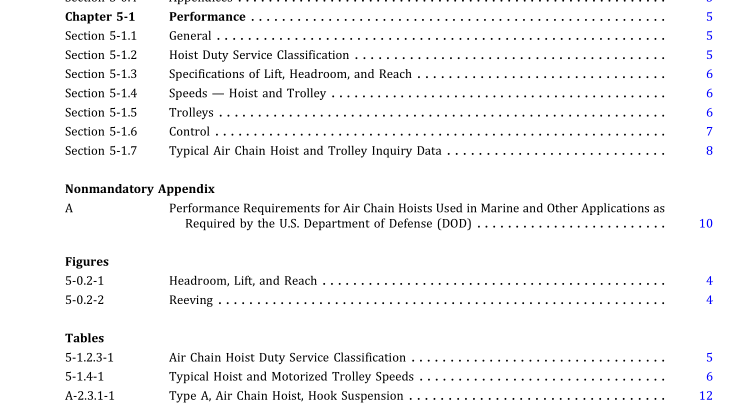ASME HST-5-2020 pdf free download.Performance Standard for Air Chain Hoists
headroom: headroom is measured with the load hook at its upper limit of travel and is the distance from the saddle of the load hook to the following locations (see Figure 5-0.2-1):
(a) saddle of the top hook on hook- suspended hoists
(b) centerline of the suspension holes on lug-suspended hoists
(c) wheel treadline on trolly-suspended hoists
hoist: a machinery unit that is used for lifting or lowering a freely suspended (unguided) load.
hoist speed: the rate of motion that the load hook obtains while lifting rated load.
hook suspended: suspension of the hoist from a trolley or rigid structure by means of a hook at top of hoist.
idler sprocket: a freely rotating device that changes the direction of the load chain. This device is sometimes called idler wheel, idler sheave, pocket wheel, or chain wheel (see Figure 5-0.2-2).
lif: the maximum vertical distance through which the load hook can travel and is the total hook movement between its upper limit of travel and its position when at the lower limit of travel (see Figure 5-0.2-1).
lifting devices, below-the-hook: devices that are not normally reeved onto the hoist chains such as hook-on-buckets,magnets, grabs, and other supplemental devices used for handling certain types of loads. The weight of these devices is to be considered part of the load to be lifted.
limit device: a device that limits equipment motion or takes control of particular functions without action of the operator when a limiting condition is reached.
load, rated: the maximum load for which a hoist or trolley is designated by the manufacturer or qualified person.
load, working: the external load applied to the hoist, including the weight of load-attaching equipment such as shackles and slings.
load block: the assembly of hook or shackle, swivel, bearing, pins, sprocket, and frame suspended by the load chain. This shall include all appurtenances reeved in the load chain. .
load chain container: a device used to collect the slack load chain.
load hook: the hook used to connect the load to the hoist.
load. sprocket: a hoist component that transmits motion to the load chain. This component is sometimes called load wheel,load sheave, pocket wheel, chain wheel, or lift wheel (see Figure 5-0.2-2).
load suspension parts: the means of suspension (hook or lug); the structure or housing that supports the load sprocket,load chain, sprockets, and load block or hook.
lug suspended: suspension of the hoist from a trolley or permanent structure by means of a bolt(s) or pin(s) through a rigid-type or swivel-type lug.
minimum radius: the smallest radius of the beam, measured to the center line of the web of the beam, on which the trolley will operate.
normal operating conditions: conditions during which a hoist is performing functions within the scope of the original design.
overload: any load greater than the rated load.
parts (lines): number of lines of chain supporting the load block or hook.
power transmission parts: the machinery components, including the gears, shafts, clutches, couplings, bearings, motors,and brakes.
qualified person: a person who, by possession of a recognized degree in an applicable field or certificate of professional standing, or who, by extensive knowledge, training, and experience, has successfully demonstrated the ability to solve or resolve problems relating to the subject matter and work.ASME HST-5 pdf download.ASME HST-5-2020 pdf free download
